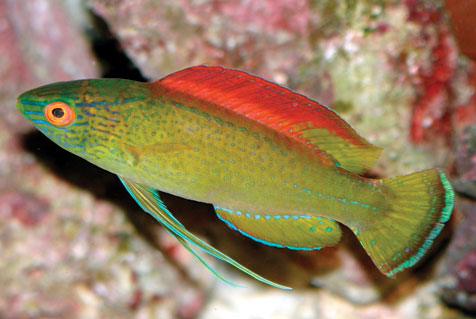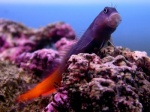Fish of the Week
Page 1 of 1
 Fish of the Week
Fish of the Week
Pyle's Fairy Wrasse
From Microcosm Aquarium Explorer
Jump to: navigation , search
Cirrhilabrus pylei - Allen & Randall, 1996
Pyle's Fairy Wrasse

Male color variant from Vanuatu. Scott W. Michael
[edit] Overview
Pyle’s Fairy Wrasse is a hardy aquarium species that should be housed with passive tankmates, like flasher wrasses, dart gobies, firefishes, razor gobies, and shrimp gobies.
Most individuals I have kept ate within hours after being placed in a quarantine tank. I did have one larger individual that did not eat for days and spent most of its time hiding. That said, I have found this species to be less flighty when initially introduced to the tank than some other larger Cirrhilabrus.
Pyle’s Fairy Wrasse is now being exported regularly from Vanuatu. The color of the male may fade some if females are not present or if kept in a brightly lit, shallow-water reef tank. (Note that this species is collected from deeper waters than many more common Fairy Wrasses.)
Colors also vary significantly from region to region. Male, also from Vanuatu.
Male, also from Vanuatu.
Family: Labridae
Other common name(s):
Native range:
Habitat: This species occurs near rocky outcroppings on sand slopes or on rubble slopes at depths of 75 to 85 m deep (244 to 276 ft.).
Maximum length: 10 cm (4 in)
Minimum aquarium size: 208 L (55 gal)
Lighting: Not Overly Bright
Water: Marine 23 °C (296 K, 73 °F) - 28 °C (301 K, 82 °F)
General swimming level: Midwater to Top
GA_googleAddSlot("ca-pub-5541711581822576", "MAQX-Banner-Inline-Species-468x60");
GA_googleFetchAds();
GA_googleFillSlot("MAQX-Banner-Inline-Species-468x60");
[edit] Feeding
Carnivore. It is important to feed these wrasses at least twice a day (three times a day is even better) to ensure they do not become emaciated and subsequently perish. A productive refugium will also help meet their nutritional needs.
Most foods will be accepted, but a variety of finely chopped fresh seafood (e.g., shrimp, marine fish flesh), frozen mysid shrimp, and a good frozen prepared food will help to maintain their colors and good health. Regularly feeding them food soaked in Selco is also a good idea. Although in nature they feed primarily from the water column, fairy wrasses will pick food off aquarium substrate as well. While algae does not form part of their natural diet, these wrasses will readily ingest freeze-dried algae (nori).
If you feed your Cirrhilabrus frequently (which I certainly recommend), you will need an effective protein skimmer to keep the aquarium water in top shape. One sign of inadequate nutrition is atrophying dorsal musculature. When this occurs, the head seems to enlarge as the adjoining muscle tissue shrinks in mass. I have seen this condition frequently in individuals housed in reef aquariums that were fed infrequently. If you are not willing to feed your fish in your reef tank at least once a day, do not purchase a fairy wrasse. If you need to remove a fairy wrasse from a reef tank, just get a good fish trap. In my estimation after years of keeping countless fairy wrasses, these fish do not seem to be especially bright. I have had numerous individuals enter an Ultralife fish trap that contained food, at the same time, even after some of these fish had had a “bad experience” (i.e., been caught and removed) with such a trap in the recent past. (Many fish learn to avoid these traps, including other labrids, after a single capture attempt.)
[edit] Aquarium Compatibility
If you are keeping male fairy wrasses with more passive zooplanktivores (e.g., small anthias, certain cardinalfishes, chromis, flasher wrasses, dart gobies), the Cirrhilabrus should be the last fish introduced.
On the other hand, if they are being kept with potentially pugnacious tankmates (e.g., pygmy angelfishes, small hawkfishes, large damselfishes, sand perch) they should be the first fish in the aquarium. I would avoid keeping these wrasses with groupers, large dottybacks, large angelfishes, or aggressive wrasses like Coris spp., large Pseudocheilinus spp., and Thalassoma spp., pugnacious surgeonfishes (e.g., the Sohal Surgeonfish, Acanthurus sohal or the Purple Tang, Zebrasoma xanthurum), most triggerfishes, and large puffers). If you have a very large tank, however, it is possible to successfully keep these wrasses with potentially aggressive tankmates.
[edit] Special Care
Do not house with overly aggressive tankmates. Stressed individuals will hang in the water column in a heads-up position. They will not hesitate to come out and feed if they are not harassed by bellicose tankmates.
[edit] Notes
The fairy wrasses are very good jumpers. Therefore, you will need to be careful when working in the tank or when extinguishing the lights. Ambient light levels should be reduced gradually so that you do not frighten your fairy wrasse. One way to prevent them from becoming startled when the aquarium lights are turned off is to mount a nightlight (e.g., a 15-watt incandescent bulb) over the aquarium. If you want to keep the aquarium open, make a PVC frame to fit on top of your aquarium and attach fiberglass screen to it or make a cover out of egg-crate material. Even when you’re in the process of working on the tank, do not leave it uncovered any longer than you have to. I know of several instances where a fairy wrasse jumped out of an uncovered tank when the aquarist’s back was turned. They can jump with such force, in fact, that they have been known to break metal halide bulbs. Fairy wrasses are also prone to going over overflow boxes (these should also be covered). When stressed (e.g., picked on by tankmates), a fairy wrasse may continuously swim near and bob at the water’s surface. If you can catch the fish, it should be removed and placed in a hospital tank for observation and a respite from other fishes.
Reference: Reef Fishes Volume 5
Image credit: SWM
Text credit: SWM
Facts about Pyle's Fairy WrasseRDF feed
Retrieved from "http://en.microcosmaquariumexplorer.com/wiki/Pyle%27s_Fairy_Wrasse"
Category: Species
From Microcosm Aquarium Explorer
Jump to: navigation , search
Cirrhilabrus pylei - Allen & Randall, 1996
Pyle's Fairy Wrasse

Male color variant from Vanuatu. Scott W. Michael
[edit] Overview
Pyle’s Fairy Wrasse is a hardy aquarium species that should be housed with passive tankmates, like flasher wrasses, dart gobies, firefishes, razor gobies, and shrimp gobies.
Most individuals I have kept ate within hours after being placed in a quarantine tank. I did have one larger individual that did not eat for days and spent most of its time hiding. That said, I have found this species to be less flighty when initially introduced to the tank than some other larger Cirrhilabrus.
Pyle’s Fairy Wrasse is now being exported regularly from Vanuatu. The color of the male may fade some if females are not present or if kept in a brightly lit, shallow-water reef tank. (Note that this species is collected from deeper waters than many more common Fairy Wrasses.)
Colors also vary significantly from region to region.
 Male, also from Vanuatu.
Male, also from Vanuatu.Family: Labridae
Other common name(s):
Native range:
- Indonesia
- Bali
- Sulawesi
- Papua New Guinea
- Vanuatu
- Philippines
Habitat: This species occurs near rocky outcroppings on sand slopes or on rubble slopes at depths of 75 to 85 m deep (244 to 276 ft.).
Maximum length: 10 cm (4 in)
Minimum aquarium size: 208 L (55 gal)
Lighting: Not Overly Bright
Water: Marine 23 °C (296 K, 73 °F) - 28 °C (301 K, 82 °F)
General swimming level: Midwater to Top
GA_googleAddSlot("ca-pub-5541711581822576", "MAQX-Banner-Inline-Species-468x60");
GA_googleFetchAds();
GA_googleFillSlot("MAQX-Banner-Inline-Species-468x60");
[edit] Feeding
Carnivore. It is important to feed these wrasses at least twice a day (three times a day is even better) to ensure they do not become emaciated and subsequently perish. A productive refugium will also help meet their nutritional needs.
Most foods will be accepted, but a variety of finely chopped fresh seafood (e.g., shrimp, marine fish flesh), frozen mysid shrimp, and a good frozen prepared food will help to maintain their colors and good health. Regularly feeding them food soaked in Selco is also a good idea. Although in nature they feed primarily from the water column, fairy wrasses will pick food off aquarium substrate as well. While algae does not form part of their natural diet, these wrasses will readily ingest freeze-dried algae (nori).
If you feed your Cirrhilabrus frequently (which I certainly recommend), you will need an effective protein skimmer to keep the aquarium water in top shape. One sign of inadequate nutrition is atrophying dorsal musculature. When this occurs, the head seems to enlarge as the adjoining muscle tissue shrinks in mass. I have seen this condition frequently in individuals housed in reef aquariums that were fed infrequently. If you are not willing to feed your fish in your reef tank at least once a day, do not purchase a fairy wrasse. If you need to remove a fairy wrasse from a reef tank, just get a good fish trap. In my estimation after years of keeping countless fairy wrasses, these fish do not seem to be especially bright. I have had numerous individuals enter an Ultralife fish trap that contained food, at the same time, even after some of these fish had had a “bad experience” (i.e., been caught and removed) with such a trap in the recent past. (Many fish learn to avoid these traps, including other labrids, after a single capture attempt.)
[edit] Aquarium Compatibility
If you are keeping male fairy wrasses with more passive zooplanktivores (e.g., small anthias, certain cardinalfishes, chromis, flasher wrasses, dart gobies), the Cirrhilabrus should be the last fish introduced.
On the other hand, if they are being kept with potentially pugnacious tankmates (e.g., pygmy angelfishes, small hawkfishes, large damselfishes, sand perch) they should be the first fish in the aquarium. I would avoid keeping these wrasses with groupers, large dottybacks, large angelfishes, or aggressive wrasses like Coris spp., large Pseudocheilinus spp., and Thalassoma spp., pugnacious surgeonfishes (e.g., the Sohal Surgeonfish, Acanthurus sohal or the Purple Tang, Zebrasoma xanthurum), most triggerfishes, and large puffers). If you have a very large tank, however, it is possible to successfully keep these wrasses with potentially aggressive tankmates.
[edit] Special Care
Do not house with overly aggressive tankmates. Stressed individuals will hang in the water column in a heads-up position. They will not hesitate to come out and feed if they are not harassed by bellicose tankmates.
[edit] Notes
The fairy wrasses are very good jumpers. Therefore, you will need to be careful when working in the tank or when extinguishing the lights. Ambient light levels should be reduced gradually so that you do not frighten your fairy wrasse. One way to prevent them from becoming startled when the aquarium lights are turned off is to mount a nightlight (e.g., a 15-watt incandescent bulb) over the aquarium. If you want to keep the aquarium open, make a PVC frame to fit on top of your aquarium and attach fiberglass screen to it or make a cover out of egg-crate material. Even when you’re in the process of working on the tank, do not leave it uncovered any longer than you have to. I know of several instances where a fairy wrasse jumped out of an uncovered tank when the aquarist’s back was turned. They can jump with such force, in fact, that they have been known to break metal halide bulbs. Fairy wrasses are also prone to going over overflow boxes (these should also be covered). When stressed (e.g., picked on by tankmates), a fairy wrasse may continuously swim near and bob at the water’s surface. If you can catch the fish, it should be removed and placed in a hospital tank for observation and a respite from other fishes.
Reference: Reef Fishes Volume 5
Image credit: SWM
Text credit: SWM
Facts about Pyle's Fairy WrasseRDF feed
| Common name | Pyle's Fairy Wrasse + |
| Family | Labridae + |
| Genus | Cirrhilabrus + |
| Image credit | SWM + |
| Lighting | Not Overly Bright + |
| Maximum length | 4 in + |
| Minimum aquarium size | 55 gal + |
| Native range | Indonesia +, Bali +, Sulawesi +, Papua New Guinea +, Vanuatu +, and Philippines + |
| Reference | Reef Fishes Volume 5 + |
| Specific name | pylei + |
| Swimming level | Midwater to Top + |
| Text credit | SWM + |
| Water max temp | 301 K (28 °C, 82 °F) + |
| Water min temp | 296 K (23 °C, 73 °F) + |
| Water type | Marine + |
Category: Species

HSCmember- Great White

- Location : Bemidji
Number of posts : 560
Page 1 of 1
Permissions in this forum:
You cannot reply to topics in this forum|
|
|

 Home
Home